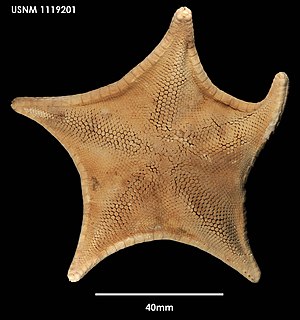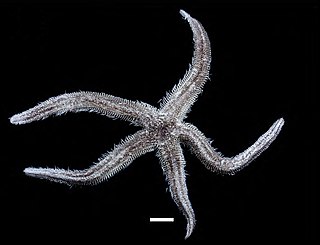Related Research Articles

Starfish or sea stars are star-shaped echinoderms belonging to the class Asteroidea. Common usage frequently finds these names being also applied to ophiuroids, which are correctly referred to as brittle stars or basket stars. Starfish are also known as Asteroids due to being in the class Asteroidea. About 1,500 species of starfish occur on the seabed in all the world's oceans, from the tropics to frigid polar waters. They are found from the intertidal zone down to abyssal depths, 6,000 m (20,000 ft) below the surface.

Asterias is a genus of the Asteriidae family of sea stars. It includes several of the best-known species of sea stars, including the (Atlantic) common starfish, Asterias rubens, and the northern Pacific seastar, Asterias amurensis. The genus contains a total of eight species in all. All species have five arms and are native to shallow oceanic areas of cold to temperate parts of the Holarctic. These starfish have planktonic larvae. Asterias amurensis is an invasive species in Australia and can in some years become a pest in the Japanese mariculture industry.

Asterias amurensis, also known as the Northern Pacific seastar and Japanese common starfish, is a seastar found in shallow seas and estuaries, native to the coasts of northern China, Korea, far eastern Russia, Japan, Alaska, the Aleutian Islands and British Columbia in Canada. Two forms are recognised: the nominate and formarobusta from the Strait of Tartary. It mostly preys on large bivalve molluscs, and it is mostly preyed on by other species of starfish. Population booms in Japan can affect the harvest of mariculture operations and are costly to combat.

Solaster paxillatus, the orange sun star, is a species of starfish found at varying depths in the northern Pacific Ocean. It is a natural predator of the starfish Asterias amurensis.

The common starfish, common sea star or sugar starfish is the most common and familiar starfish in the north-east Atlantic. Belonging to the family Asteriidae, it has five arms and usually grows to between 10–30 cm across, although larger specimens are known. The common starfish is usually orange or brownish in color, and sometimes violet; specimens found in deeper waters are pale. The common starfish is found on rocky and gravelly substrates where it feeds on mollusks and other benthic invertebrates.

Ceramaster patagonicus, the cookie star, is a species of sea star. It is bright orange or yellow in colour. Its arms are short and it has no spines. It is a deep water species and lives on rocky sea beds. Its diet includes sponges.

The seven-arm octopus is one of the two largest known species of octopus; based on scientific records, it has a maximum estimated total length of 3.5 m (11 ft) and mass of 75 kg (165 lb). The only other similarly large extant species is the giant Pacific octopus, Enteroctopus dofleini.

Calliostoma zizyphinum, common name the European painted top shell, is a species of sea snail, a marine gastropod mollusk in the family Calliostomatidae.

Henricia is a large genus of slender-armed sea stars belonging to the family Echinasteridae. It contains about fifty species.

Luidia superba is a tropical species of starfish in the family Luidiidae. A single specimen was found off the Pacific coast of Colombia in 1888; the species has since been found in the Galapagos Islands. It is endemic to this area and has not been recorded elsewhere.

Leptasterias hexactis is a species of starfish in the family Asteriidae, commonly known as the six-rayed star. It is found in the intertidal zone of the western seaboard of the United States. It is a predator and is unusual among starfish in that it broods its eggs and young.

Asterias forbesi, commonly known as Forbes sea star, is a species of starfish in the family Asteriidae. It is found in shallow waters in the northwest Atlantic Ocean and the Caribbean Sea.
Orchitophrya stellarum is a species of single-celled marine ciliates, a member of the class Oligohymenophorea. It is found living freely in the north Atlantic and Pacific Oceans but is also parasitic, being found inside the gonads of starfish.

Evasterias troschelii is a species of starfish in the family Asteriidae. Its common names include the mottled star, false ochre sea star and Troschel's true star. It is found in Kamchatka and the north western coast of North America.

Sea star wasting disease or starfish wasting syndrome is a disease of starfish and several other echinoderms that appears sporadically, causing mass mortality of those affected. There are around 40 different species of sea stars that have been affected by this disease. The disease seems to be associated with raised water temperatures in some places, but not others. It starts with the emergence of lesions, followed by body fragmentation and death. In 2014 it was suggested that the disease is associated with a single-stranded DNA virus now known as the sea star-associated densovirus (SSaDV); however, sea star wasting disease is still not fully understood.

Marthasterias is a genus of starfish in the family Asteriidae. It is monotypic and the only species in the genus is Marthasterias glacialis, commonly known as the spiny starfish. It is native to the eastern Atlantic Ocean.

Asterias rollestoni is a common starfish native to the seas of China and Japan, and not known from the far north or the American coasts of the eastern Pacific.
Asterias rathbuni is a starfish native to the Pacific coasts of Alaska in the United States and Far East Russia. There are two subspecies.
Asterias argonauta is a starfish native to the Pacific coasts of Far East Russia.
Asterias versicolor is a species of starfish native to the southern coasts of Japan southwards to the South China Sea.
References
- 1 2 3 4 5 6 Дьяконов, А.М. (1950). Морские звезды морей СССР [Определители по фауне. 34 (Tableaux analytiques de la faune de l'URSS 34)] (in Russian). St. Petersburg: Акаде́мии Нау́к СССР. p. 127.
- 1 2 Mah, Christopher L. (2008). "Asterias microdiscus Djakonov, 1950". World Register of Marine Species (WoRMS). Flanders Marine Institute. Retrieved 13 November 2019.
- ↑ Jangoux, Michel; Lawrence, John M. (1 June 2001). Echinoderm studies 6. CRC Press. p. 262. ISBN 9789058093011.
- 1 2 3 Smirnov, Igor S. (2019). "Sea Stars (Asteroidea) Catalogue • Asterias". Research Collections of the Zoological Institute RAS. Zoological Institute of the Russian Academy of Sciences. Retrieved 13 November 2019.